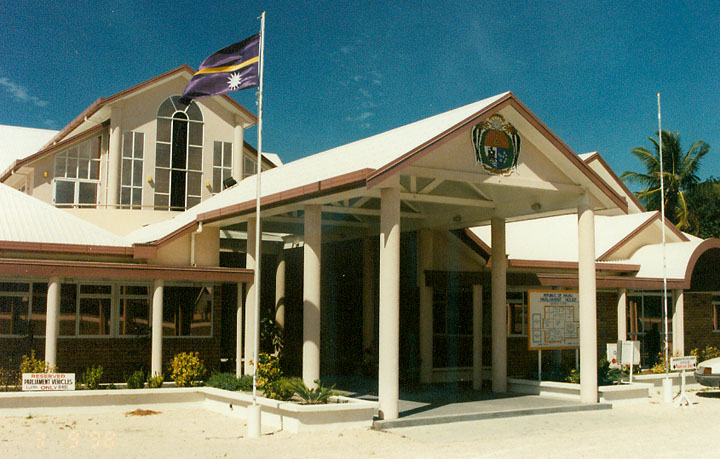Flag of Nauru on:
[Wikipedia]
[Google]
[Amazon]
 Following the
Following the
 Following the
Following the independence
Independence is a condition of a person, nation, country, or state in which residents and population, or some portion thereof, exercise self-government, and usually sovereignty, over its territory. The opposite of independence is the stat ...
of Nauru
Nauru ( or ; na, Naoero), officially the Republic of Nauru ( na, Repubrikin Naoero) and formerly known as Pleasant Island, is an island country and microstate in Oceania, in the Central Pacific. Its nearest neighbour is Banaba Island in ...
, the flag of Nauru ( na, anidenin Naoero) was raised for the first time. The flag, chosen in a local design competition, was adopted on independence day, 31 January 1968. The design symbolically depicts Nauru's geographical position, with a star just south of the Equator
The equator is a circle of latitude, about in circumference, that divides Earth into the Northern and Southern hemispheres. It is an imaginary line located at 0 degrees latitude, halfway between the North and South poles. The term can also ...
.
Proportions and symbolism
The flag reflects the geographical location of theisland nation
An island country, island state or an island nation is a country whose primary territory consists of one or more islands or parts of islands. Approximately 25% of all independent countries are island countries. Island countries are historical ...
.
The narrow gold stripe with a width of of the length of the flag represents the Equator
The equator is a circle of latitude, about in circumference, that divides Earth into the Northern and Southern hemispheres. It is an imaginary line located at 0 degrees latitude, halfway between the North and South poles. The term can also ...
. The stripe along with the star signifies the location of the island in the Pacific Ocean
The Pacific Ocean is the largest and deepest of Earth's five oceanic divisions. It extends from the Arctic Ocean in the north to the Southern Ocean (or, depending on definition, to Antarctica) in the south, and is bounded by the conti ...
one degree south of the Equator. The separation of the blue flag cloth into two equal parts recalls the saga
is a series of science fantasy role-playing video games by Square Enix. The series originated on the Game Boy in 1989 as the creation of Akitoshi Kawazu at Square. It has since continued across multiple platforms, from the Super NES to th ...
, that the first inhabitants were to have been brought to Earth from two boulders.
Nauru itself is symbolised by a white 12-pointed star. The twelve points on the star represent the island's twelve original tribes. The following twelve tribes are:
*Deiboe
*Eamwidara
*Eamwit
*Eamwitmwit
*Eano
*Eaoru
*Emangum
*Emea
*Irutsi
*Iruwa
*Iwi
*Ranibok
The blue signifies the Pacific Ocean
The Pacific Ocean is the largest and deepest of Earth's five oceanic divisions. It extends from the Arctic Ocean in the north to the Southern Ocean (or, depending on definition, to Antarctica) in the south, and is bounded by the conti ...
, while the white colour of the star represents phosphate
In chemistry, a phosphate is an anion, salt, functional group or ester derived from a phosphoric acid. It most commonly means orthophosphate, a derivative of orthophosphoric acid .
The phosphate or orthophosphate ion is derived from phosph ...
, a former major natural resource of the country.
Construction Sheet
Creation and adoption
The flag was created by a resident employed by theAustralia
Australia, officially the Commonwealth of Australia, is a sovereign country comprising the mainland of the Australian continent, the island of Tasmania, and numerous smaller islands. With an area of , Australia is the largest country by ...
n flag manufacturer Evans. It was officially adopted on 31 January 1968. Unlike some flags of Pacific
The Pacific Ocean is the largest and deepest of Earth's five oceanic divisions. It extends from the Arctic Ocean in the north to the Southern Ocean (or, depending on definition, to Antarctica) in the south, and is bounded by the contine ...
nations (e.g., that of Tuvalu
Tuvalu ( or ; formerly known as the Ellice Islands) is an island country and microstate in the Polynesian subregion of Oceania in the Pacific Ocean. Its islands are situated about midway between Hawaii and Australia. They lie east-northea ...
), Nauru
Nauru ( or ; na, Naoero), officially the Republic of Nauru ( na, Repubrikin Naoero) and formerly known as Pleasant Island, is an island country and microstate in Oceania, in the Central Pacific. Its nearest neighbour is Banaba Island in ...
's flag has evoked little controversy.
Other flags of Nauru
Historical flags of Nauru
See also
* Coat of arms of Nauru * Nauru graph, named after its resemblance to the 12-pointed star on the flag *Flag of Curaçao
The national flag of Curaçao represents the country of Curaçao as well as the island area within the Netherlands Antilles from 1984 until its dissolution in 2010.
The flag is a blue field with a horizontal yellow stripe slightly below the m ...
References
Flags introduced in 1968Flag
A flag is a piece of fabric (most often rectangular or quadrilateral) with a distinctive design and colours. It is used as a symbol, a signalling device, or for decoration. The term ''flag'' is also used to refer to the graphic design empl ...
National flags
1968 establishments in Nauru
{{Nauru-stub